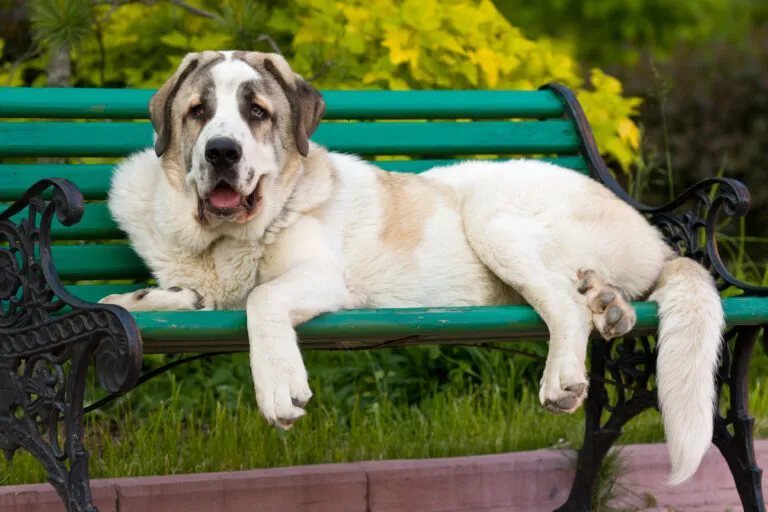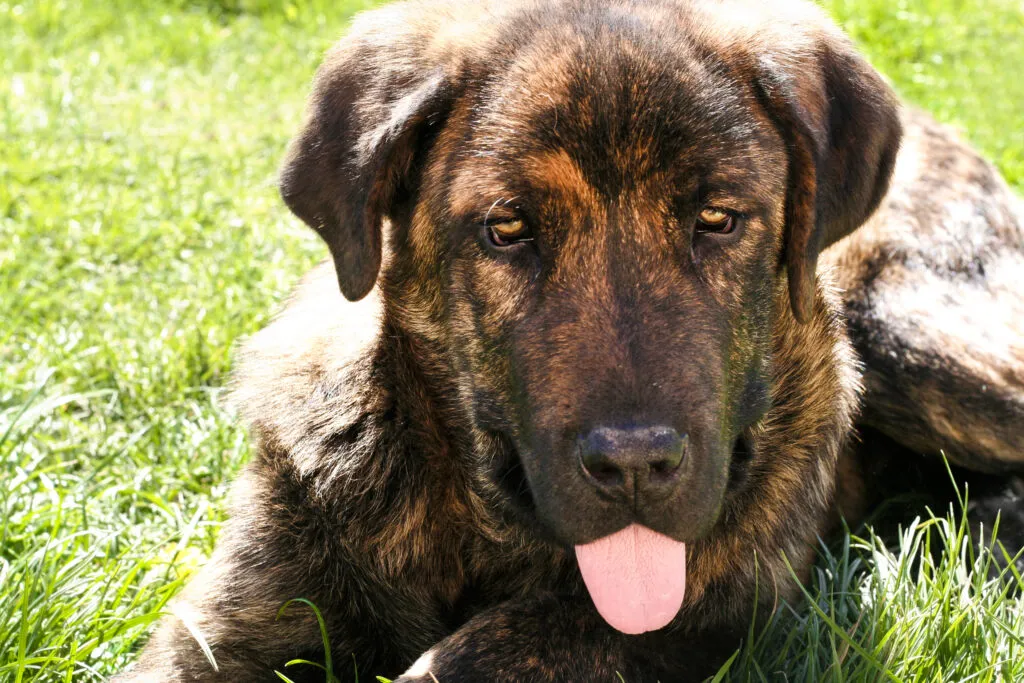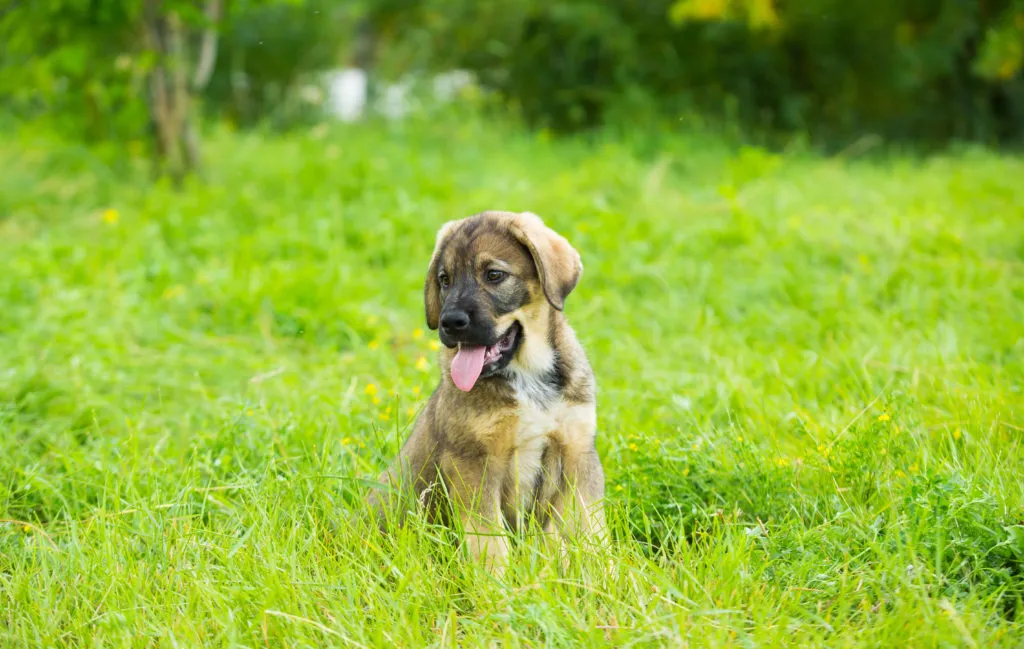Medium Size Poodle
The Mastín Español, a giant dog with a powerful bark, certainly doesn’t lack self-confidence. As a former herding dog, it was capable of taking on wolves, bears or other livestock thieves. Yet, despite its enormous power and dominance, the Spanish Mastiff exhibits remarkable self-control.

© Dixi_ / stock.adobe.com
The Spanish Mastiff moves with quiet authority, fully aware of its immense strength and presence
Movement, power and endurance already characterised the ancestors of the Mastín Español. Though little is known about the origin of the breed, it is believed their forebears were among the large dogs brought to the Iberian Peninsula by the Greeks and Phoenicians approximately 2,000 years ago.
These strong, brave dogs, with their innate protective instinct, became especially valued by Spanish migratory shepherds. As early as the 12th century, they accompanied large flocks of sheep on their migrations, reliably protecting them from wolves, bears and livestock thieves. A record from the 18th century in Castile suggests a flock of 1,000 sheep was typically accompanied by five Mastiffs. Therefore, each Mastiff looked after about 200 sheep almost entirely without the shepherd’s direct supervision.
Due to their excellent qualities as herding dogs, Spanish Mastiffs were highly respected. They were well-provided for during their treks, with as much food carried for the dogs as for the shepherds. Injuring a Mastín could result in severe penalties from the Mesta, the medieval organisation of Spanish shepherds, and owning such a valuable dog required Mesta approval.
Even today, the Mastín Español remains invaluable for Spanish shepherds, guarding flocks on local pastures and during migrations. Except for the Pyrenees of Aragon and Navarre and the Monegros region, where the Pyrenean Mastiff is prevalent, the Mastín Español is found throughout Spain, particularly in the mountains of Asturias and Leon, the Cantabrian mountain range, and Extremadura, as well as in all areas impacted by migratory shepherding.
In these regions, the Mastín Español is also known as Mastín Leonés, Mastín Extremeño, and Mastín Manchego. In contrast to Spain, the breed is rather rare in other European countries.
The Mastín Español’s self-assured, occasionally dominant nature is evident in its appearance. Shyness is as foreign to this confident giant as unnecessary aggressiveness. Its muscular body with a compact bone structure exudes power and strength. With a minimum height of 77cm for males and 72cm for females, the Mastín Español undoubtedly belongs to the large breeds.
In Spain, where some breeders focus on pure utility disregarding FCI standards, heights up to 100cm and weights up to 110kg are possible. However, even those bred according to FCI standards impress with weights up to 70kg.
The smooth, not very long fur enhances its well-proportioned, balanced build. Its fur, which moults twice a year, is thick and weather-resistant, reflecting the origins of this Spanish herding dog that endured the cold highlands on its treks.
A Spanish Mastiff shows considerable variety in colour. According to FCI, solid colours are preferred, ranging from yellow, fawn, red, and reddish-brown to black and wolf grey. However, combined fur colours such as brindled or speckled are also allowed. A white collar is permitted too.
While the Mastiff’s muzzle is exceptionally long, its ears are relatively small and drooping. The short, robust neck exhibits a double dewlap. Its chest is deep and broad. Despite its bulk, the Spanish Mastiff remains an agile dog that exudes “harmony in stance and movement” according to its standard.
 © Juan Aunión / stock.adobe.com
© Juan Aunión / stock.adobe.com
The Mastín Español is completely aware of its strength. This heavy giant with a deep, rough voice acts with supreme confidence, aware that it can intimidate and command respect from many people and animals. Therefore, it doesn’t need to unnecessarily flaunt its strength.
While its strong protective instinct and natural distrust of strangers make it an excellent watchdog, it never attacks without reason. Spanish Mastiffs aim to protect their family and would defend them to the outmost, but they can – thanks to their intelligence – discern when their intervention is required and when it isn’t.
Fundamentally, these Spanish breed dogs are very balanced and good-natured. They have a high tolerance threshold and aren’t easily perturbed by other dogs. Their lively and joyful personality and gentle, almost tender manner with their loved ones make the herding and guard dog a cherished companion and family dog.
The Mastín Español, happiest in the company of its family, loves playing with children and, with proper training and socialisation, can be kept even in a family with young children. While it knows its immense strength and uses it sparingly, small children should not be left unsupervised with this large, heavy dog.
Mastiffs are considered eager learners, sometimes even trainable, but potential owners should understand that they don’t aim to please their humans at any cost. The Mastín Español is independent-minded and, although it enjoys close interaction with its family, can become stubborn if it disapproves of something.
Especially males can display quite dominant behaviour if too much pressure is applied during training. This might give an outsider the impression that the Mastiff is training its owner rather than the other way around. Essential in training a Spanish Mastiff are, therefore, patience and trust, along with the necessary consistency.
 © caxa75onohoi / stock.adobe.com
© caxa75onohoi / stock.adobe.com
The number of breeders outside Spain is relatively limited. You can obtain an overview of breeders from national associations of FCI member states. Within the FCI, the world’s largest canine organisation, the Spanish Mastiff is listed under number 91 in Group 2 (Pinscher and Schnauzer, Molossoids, Swiss Mountain Dogs) and Section 2.2 (Mountain Dogs).
If you’re interested in buying this breed as a companion and family dog, ensure the breeder follows FCI standards and has the relevant certificates. This ensures that key traits and health considerations are maintained.
If you are fortunate enough to own a purebred Mastiff puppy bred according to FCI standards, you generally don’t need to worry about breed-specific diseases. The Mastín Español is considered a very robust dog breed, thanks to its physical constitution, it’s quite resistant to diseases. However, like all large breeds, it is prone to hip dysplasia (HD), which can be mitigated by careful breeding practices.
Bone and joint problems often stem from rapid growth and excessive weight gain in dogs, so breeders and owners must ensure that young dogs aren’t overfed. Vets recommend high-quality food, ideally split into three meals daily. To reduce the risk of gastric torsion, avoid overfeeding during a single meal time and excessive activity after eating.
The perfect diet can’t be universally defined as every dog has different needs influenced by factors like size, activity level, and health condition. Large dogs like the Spanish Mastiff have higher energy requirements and thus need more food. However, you should monitor your dog’s weight to prevent obesity. Generally, dogs require a meat-rich diet with relatively little grain. Different feeding methods, such as dry and wet food or BARF (Biologically Appropriate Raw Feeding), can be considered. Always provide your dog with ample fresh water.
The Mastín Español is relatively low-maintenance when it comes to physical care. Brushing occasionally and cleaning the ears usually suffice. However, during the moulting seasons in spring and autumn, coat care becomes more demanding.
Training this large breed is somewhat more challenging. For those who expect complete obedience or a dog always eager to please, the Spanish Mastiff may not be suitable. Its strong self-confidence and intelligence may lead it to “do its own thing”. If subjected to excessive pressure or inappropriate strictness, the Mastiff can become stubborn and challenging even for experienced dog owners.
This doesn’t imply the Spanish Mastiff is untrainable. Understanding the characteristics of your charismatic four-legged friend allows you to train it with empathy, patience, and kind firmness into a pleasant and loyal companion. A well-trained Mastiff enjoys relaxing at home after a long walk, cherishing the affection of its loved ones. To encourage its naturally balanced temperament, plenty of exercises is essential. Activities like fetching can bring some Spanish Mastiffs delight.
Before getting a Mastín Español, consider the costs and time involved. You’ll need basic equipment, including a lead, a basket, blankets, bowls, toys, and carriers. Another significant expenditure is the substantial amount of food required for a dog of this size. Regular vet visits and potential treatment costs should also be considered.
Think ahead about whether you can offer an appropriate environment for a Spanish Mastiff. A large dog like this isn’t suited for a small flat. A house with a garden, preferably with an overview of the surroundings it can monitor, is ideal for this originally herding dog. Here, it can indulge its protective and guarding instincts and feel needed within the family. If you’re not a shepherd, rest assured: a flock of sheep isn’t necessary to keep a Spanish Mastiff content.
Interested in the Spanish Mastiff? You might also like these breeds:
Fans of the Bearded Collie agree that those who aren't familiar with this dog breed simply have to get acquainted with it. And those who have experienced how a Bearded Collie bolts across meadows with its flowing fur, how it rolls around full of energy and joy and how it attentively and observantly takes into account its owners wishes become simply addicted to this original dog breed and its unique charm.
The Goldendoodle isn't a breed, but a pairing between Golden Retrievers and Medium or Standard Poodles. Marketed as a low-maintenance dog for allergy sufferers, this hybrid is enjoying increasing popularity amongst dog lovers, similar to the Labradoodle.